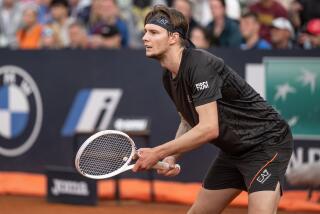Captain Gullikson Makes Recruiting Trip, Gets Sampras
- Share via
BROOKLINE, Mass. — Back in January, in the dead of winter, Tom Gullikson hopped on a plane for what may have been the most important mission of his tenure as U.S. Davis Cup captain.
Gullikson met with Pete Sampras and Andre Agassi--the top two singles players in the United States, and probably the world--who had both been reluctant to commit to the team. The captain came away from his meetings empty handed, but he would eventually get one of the two.
After balking initially, Sampras said this spring that he would join the team for its quarterfinal tie against Australia July 16-18--even offering to play only doubles so as not to upset those who had been along from the start.
“We’re very delighted that he’s back on the team,” Gullikson said last week at the Longwood Cricket Club, where the first Davis Cup was played 99 years ago. “Obviously, we’d love to have Andre back. He chose not to. That’s his decision; everybody can choose to play or not to play. This is America. This isn’t some communist country where if you don’t play they take away your passport.”
As it stands, Todd Martin and Jim Courier will play singles against Patrick Rafter and Lleyton Hewitt, and Sampras and Alex O’Brien will play doubles against the “Woodies”--Todd Woodbridge and Mark Woodforde.
But Martin has said he would gladly step aside to allow Sampras to play singles. Although Gullikson has been coy, saying it’s a “team decision” that will take everyone’s feelings into account, few doubt that Sampras, fresh off his record sixth Wimbledon singles crown and ranked No. 3 in the world behind Agassi and Rafter, will play at his strength.
The Australians have already done some shuffling of their own to replace Mark Philippoussis, who hurt his knee in the Wimbledon quarterfinals against Sampras and was replaced by Hewitt.
Although it is technically Australia’s turn to be the host, the site was moved in order to commemorate the first Davis Cup, which was played at Longwood in 1900 after Dwight Davis commissioned Shreve, Crump and Low to make a silver bowl for $750 and offered it as a prize for an international lawn tennis competition.
As a 20-year-old just out of Harvard, the son of wealthy St. Louis merchants, Davis designed the tournament format that is still used today--a three-day event with two singles matches each on the first and third days and a doubles match on the second. He captained and played for the first American team, which beat Britain 3-0.
Davis was twice the national doubles champion and ranked as high as second in singles, in 1899. After failing in a bid for a U.S. Senate seat, he served as secretary of war under Calvin Coolidge and then governor-general of the Philippines.
But he is best remembered as the founder of international tennis and the tournament that bears his name.
“He was a hell of a guy. A marvelous man. He had all the good motives for tennis and he was a fine sportsman,” said Don Budge, a Davis Cup veteran who helped return the Cup to the United States in 1937 after a 10-year absence. “Whatever he represented was good for tennis.”
Budge, who’s now 84, remembers the Cup’s heyday, when victorious teams were greeted with ticker-tape parades like those that welcomed aviators and astronauts. And he remembers the days when U.S. Davis Cup captains didn’t have to talk people into playing.
“If we were ever asked to play for the Davis Cup team, we would drop everything and play,” Budge said. “You’re playing for your country. We’d feel awfully bad if we lost. And when they say ‘Game to the United States,’ it really hits home.”
Gullikson didn’t sign on as Davis Cup captain just so he could fly around the country trying to recruit reluctant players. So when he headed West for an extended meeting with Sampras and Agassi, he didn’t try to wine and dine them into submission, or beat down their resistance with an appeal to their patriotism.
“I was trying to sit down one on one and have some honest conversation, without their agents,” Gullikson said. “Look them in the eye and talk to them. . . . In a perfect world, every American would make themselves available at the beginning of every year, and they’d all want to be a part of it every time. But it’s not like that.”
Budge, who will be at Longwood for the tie, also tried to be understanding.
“It’s a different feeling than we had,” he said. “I can’t condemn them for that because the game has changed. Tennis players have to make a little money. So, now they can.”
More to Read
Go beyond the scoreboard
Get the latest on L.A.'s teams in the daily Sports Report newsletter.
You may occasionally receive promotional content from the Los Angeles Times.










